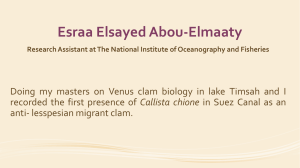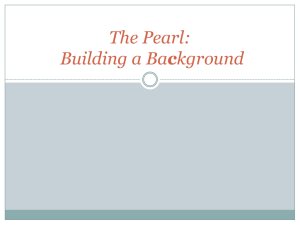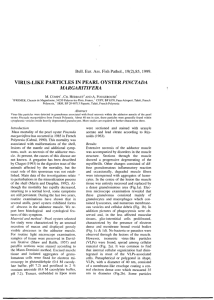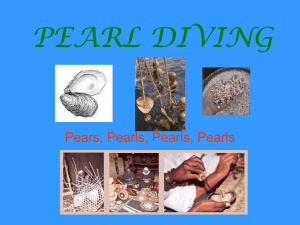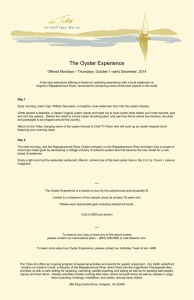Abundance and Population Structure of the Blacklip Pearl
advertisement
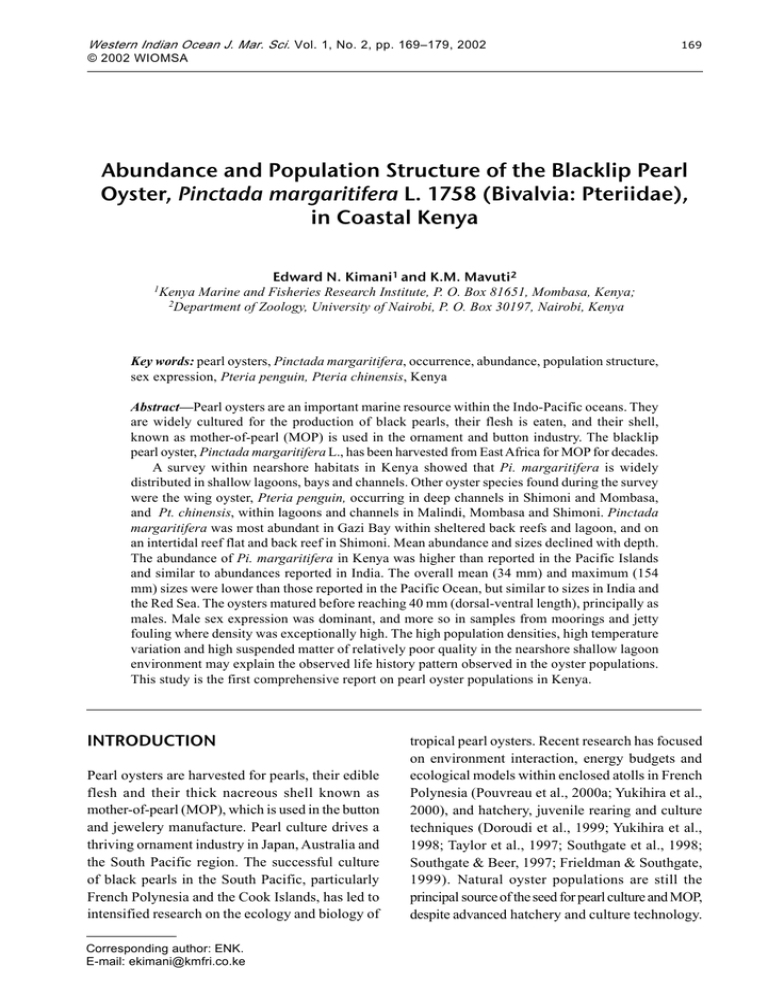
ABUNDANCE PINCTADA MARGARITIFERA Western Indian Ocean J. Mar. Sci. Vol. OF 1, No. 2, pp. 169–179, 2002 IN KENYA 169 © 2002 WIOMSA Abundance and Population Structure of the Blacklip Pearl Oyster, Pinctada margaritifera L. 1758 (Bivalvia: Pteriidae), in Coastal Kenya Edward N. Kimani1 and K.M. Mavuti2 Marine and Fisheries Research Institute, P. O. Box 81651, Mombasa, Kenya; 2Department of Zoology, University of Nairobi, P. O. Box 30197, Nairobi, Kenya 1Kenya Key words: pearl oysters, Pinctada margaritifera, occurrence, abundance, population structure, sex expression, Pteria penguin, Pteria chinensis, Kenya Abstract—Pearl oysters are an important marine resource within the Indo-Pacific oceans. They are widely cultured for the production of black pearls, their flesh is eaten, and their shell, known as mother-of-pearl (MOP) is used in the ornament and button industry. The blacklip pearl oyster, Pinctada margaritifera L., has been harvested from East Africa for MOP for decades. A survey within nearshore habitats in Kenya showed that Pi. margaritifera is widely distributed in shallow lagoons, bays and channels. Other oyster species found during the survey were the wing oyster, Pteria penguin, occurring in deep channels in Shimoni and Mombasa, and Pt. chinensis, within lagoons and channels in Malindi, Mombasa and Shimoni. Pinctada margaritifera was most abundant in Gazi Bay within sheltered back reefs and lagoon, and on an intertidal reef flat and back reef in Shimoni. Mean abundance and sizes declined with depth. The abundance of Pi. margaritifera in Kenya was higher than reported in the Pacific Islands and similar to abundances reported in India. The overall mean (34 mm) and maximum (154 mm) sizes were lower than those reported in the Pacific Ocean, but similar to sizes in India and the Red Sea. The oysters matured before reaching 40 mm (dorsal-ventral length), principally as males. Male sex expression was dominant, and more so in samples from moorings and jetty fouling where density was exceptionally high. The high population densities, high temperature variation and high suspended matter of relatively poor quality in the nearshore shallow lagoon environment may explain the observed life history pattern observed in the oyster populations. This study is the first comprehensive report on pearl oyster populations in Kenya. INTRODUCTION Pearl oysters are harvested for pearls, their edible flesh and their thick nacreous shell known as mother-of-pearl (MOP), which is used in the button and jewelery manufacture. Pearl culture drives a thriving ornament industry in Japan, Australia and the South Pacific region. The successful culture of black pearls in the South Pacific, particularly French Polynesia and the Cook Islands, has led to intensified research on the ecology and biology of Corresponding author: ENK. E-mail: ekimani@kmfri.co.ke tropical pearl oysters. Recent research has focused on environment interaction, energy budgets and ecological models within enclosed atolls in French Polynesia (Pouvreau et al., 2000a; Yukihira et al., 2000), and hatchery, juvenile rearing and culture techniques (Doroudi et al., 1999; Yukihira et al., 1998; Taylor et al., 1997; Southgate et al., 1998; Southgate & Beer, 1997; Frieldman & Southgate, 1999). Natural oyster populations are still the principal source of the seed for pearl culture and MOP, despite advanced hatchery and culture technology. 170 E.N. KIMANI AND K.M. MAVUTI Some recent studies on blacklip pearl oyster stocks have been conducted in French Polynesia (Morize, 1982; Intes et al., 1985; Intes & Coeroli, 1982), the Cook Islands (Zanini & Salvat, 2000; Sims, 1992), Hawaii (Rodgers et al., 2000), the Indian Ocean (Alargarswami, 1983; Alargarswami et al., 1987) and the Red Sea (Elnaeim, 1984). These studies describe the occurrence, standing stocks, distribution and population structure of pearl oysters. Although blacklip pearl oysters are known to occur in East Africa (Samoilys, 1981; Richmond & Rabesandaratana, 1997), the only reported study is on oyster settlement on artificial collectors (Bautil & Boulle, 1992). Pearl oyster shell has been exported from eastern Africa to Asia and Europe for decades, and black pearl culture was recently started in the Seychelles. The study reported here describes blacklip pearl oyster occurrence, abundance and population structure from surveys conducted within nearshore and fringing reef habitats lying between Malindi and Shimoni, in coastal Kenya between 1998 and 1999. SOMALIA R. Tana KENYA N R. Sabaki Malindi-Watamu Marine Park/Reserve EA N # # DI AN # Kanamai Mombasa Marine Park/ Marine Reserve IN Mombasa OC # Vipingo Diani Shimoni TANZANIA Gazi Bay Funzi Bay # # Wasini Island Kisite Marine Park/ 50 Marine Reserve Fig. 1. Map of coastal Kenya showing study areas 0 50 100 Km ABUNDANCE OF PINCTADA MARGARITIFERA IN KENYA MATERIALS AND METHODS Study area The study was conducted within the nearshore reefs, lagoons and channels in eight localities along the coast of Kenya, namely Malindi, Vipingo, Kanamai, Mombasa, Diani, Gazi, Funzi and Shimoni (Fig. 1). The lagoons are shallow, often a few metres to more than 10 m deep in the channels. The tides are semidiurnal with 2–4 m amplitude, creating strong tidal currents that flush the lagoons during ebb tide (Kirugara, 1998). Seagrass beds are common within the lagoons with sandy bottoms while isolated coral heads occur on more consolidated substrates. The dominant ocean current is the East Africa Coastal Current that flows northwards, driven by the Southeast Monsoon from March to October. The Somali current influences the north Kenya coast between October and March, when the strength of the East African Coastal Current declines, during the Northeast Monsoons (McClanahan, 1988). The currents, monsoon winds and runoff from the major rivers determine the seasonality of physical, chemical and biological processes in the East African coast. Sampling Sampling of the eight localities for occurrence and population density of oysters was done for two hours at low spring during the day by either wading, snorkelling, or scuba diving. In each of the study sites, replicate belt transects were surveyed by laying a 50 m weighed nylon line, marked every 5 metres, parallel to the reef. Two people carefully searched and collected all oysters one metre on either side of the transect line. On the return swim the observers changed sides and conducted another search so as to avoid bias and to enhance search efficiency. The belt transect method was used in Malindi, Mombasa, Gazi Bay, Funzi Bay and Shimoni. However, the method was found to be inefficient in sites with very low population densities, thus extensive searches outside the density survey transects were adopted in Vipingo and Kanamai lagoons and in the Kisite MPA. The sizes of the oysters were taken as the dorsal ventral measurement (DVM) (Sims, 1993) using 171 callipers. To determine sex, fresh oysters were opened and three slide smears made from different parts of the gonad and examined under a light microscope. Individuals with no distinct gonad were regarded as juveniles, those with sperm as males, those with eggs as females and those with both eggs and sperms as hermaphrodites. In addition, pearl oysters fouling boat moorings in Shimoni, Gazi and Malindi and a jetty in Shimoni were also examined for sex expression. Data were tested for homogeneity of variance and normality using Levene’s and KolmorogovSmirnov tests respectively. The Kruskal-Wallis median test was used to compare abundance and sizes in study areas, sites and depths. RESULTS Occurrence and abundance The blacklip pearl oyster Pinctada margaritifera occurred throughout the areas surveyed, with highest densities in Malindi, Gazi and Shimoni. Individuals were found attached to a variety of substrates including other bivalves such as penshells, mussels, honeycomb oysters, teeth oysters shells, dead and live corals and on bare rock. Table 1 shows the occurrence, substrate and abundance of blacklip pearl oysters in the depths surveyed. In all, a total of 1446 blacklip pearl oysters were collected in 75 100-m2 belt transects with a pooled mean of 19.2 ± 40.2 (Table 1). Oyster abundance ranged from 0 to 224, resulting in a high coefficient of variation (209.3 %) in the whole data set. The data on oyster density were not normally distributed (Kolmogorov-Smirnov test, χ2 = 72.7, P < 0.05) and not homogeneous (Levene’s test F = 7.44, P < 0.05). Therefore, the Kruskal-Wallis median test was adapted to compare densities in study areas, sites and depths because it is suitable when many cases in the data are at either extreme of the scale. The overall oyster densities in the study areas were significantly different (χ2 = 24.9, P < 0.05). Pairwise comparisons of densities show that overall densities in Malindi, Mombasa, and Shimoni were similar, while Gazi had significantly higher densities than the three locales (P < 0.05). No oysters were found in offshore reefs in Shimoni 172 E.N. KIMANI AND K.M. MAVUTI Table 1. Study areas, sites, dominant substrate, depth and abundance of blacklip pearl oysters, Pinctada margaritifera L (n = number of replicate transects) n No./100 m 2 (± SD) Intertidal 0–5 5–16 2–12 6 14 12 4 36 105.3 ± 97.8 9.8 ± 7.2 6.0 ± 3.5 0 23.3 ± 52.7 Sand, seagrass 0–2 1 Gazi Backreef Lagoon Total Seagrass/sand Seagrass/sand 0–2 0–2 5 10 15 21.0 ± 5.9 45.0 ± 28.3 37.1 ± 26.0 Mombasa Reef platform Lagoon Reef slope Total Rock, sand, coralline algae Live/dead coral, sand Dead/live coral intertidal 0–2 5–20 3 5 4 12 2.3 ± 4.0 0.6 ± 0.9 0 0.8 ± 2.0 Malindi Reef platform Lagoon Reef slope Submerged reef crest Total Coral stands, seagrass, sand Dead/live coral, sand Dead/live coral Dead/live coral intertidal 0–12 3–12 3–5 2 4 3 2 11 0 7.5 ± 5.4 0 0 2.7 ± 4.8 75 19.2 ± 40.2 Study area/site Shimoni Reef platform Back reefs Channel Offshore reefs (slopes) Total Funzi Lagoon Dominant substrate Depth (m) Bare rock, mussels Soft coral, sand, bare rock Sand, rock, sponges Live and dead coral Grand Total and Malindi, or on reef slope sites in Malindi, Mombasa and Shimoni. In general, the mean densities of pearl oysters declined with depth (Table 2). The pooled densities in the intertidal zone and 0–5 m depth, were, however statistically similar (χ 2 = 0.230, P = 0.631). The densities in 5–10 m and >10 m, were also statistically similar (χ2 = 0.0296, P = 0.863). The densities in the intertidal zone and 0–5m depth were significantly higher than densities at 5–10 m and > 10 m depth (P < 0.05). Comparisons of 7 densities in study sites within the study areas show that densities in the lagoon and backreef in Gazi bay were not significantly different (χ2 = 0.038, P = 0.845). Similarly, densities in the intertidal reef platform and the channel in Shimoni were not significantly different (χ2 = 3.696, P = 0.054). Thirty oysters were collected in Malindi within 11 belt transects. The mean density of oysters in Malindi was 2.7 ± 4.8, and was the second-lowest, after Mombasa. The oysters were attached on branches of dead Acropora to 5 m depth and on Table 2. Densities per 100 m2 of pearl oysters, Pinctada margaritifera, in the intertidal zone, 0–5, 5–10 and > 10 m depth in study areas (numbers of specimens are given in parentheses) Depth Intertidal zone 0–5 m 5–10 m > 10 m Total Malindi 0 (2) 7.3 ± 6.6 (3) 4.0 ± 5.6 (4) 0 (2) 3.3 ± 5.1 (11) Mombasa Gazi Funzi 2.3 ± 4.0 (3) – – 0.6 ± 0.9 (5) 37.1 ± 26.0 (15) 7 (1) 0 (2) – – 0 (2) – – 1.0 ± 2.2 (12) 37.1 ± 26.0 (15) 7 (1) Shimoni 105.3 9.8 4.4 4.6 12.2 Total ± 97.8 (6) 58.0 ± 7.3 (14) 21.9 ± 4.5 (10) 2.4 ± 3.4 (6) 3.0 ± 13.4 (36) 14.9 ± 87.9 (11) ±22.8 (33) ± 3.8 (19) ± 3.6 (12) ±20.0 (75) ABUNDANCE OF PINCTADA MARGARITIFERA IN KENYA Montipora branches in deeper water between 5 and 12 m. Belt transects in the reef slope and on a submerged reef dominated by dead and live Montipora yielded no pearl oysters in Malindi. A total of 452 oysters were collected in 15 transects in two sites within Gazi Bay. The mean population density within a current-swept channel and the adjacent Thalassodendron ciliatum seagrass bed (45.2 ± 28.7) was higher than in the sheltered back reef site (21.0 ± 5.9) in Gazi Bay. However, the difference was not significant (χ2 = 0.038, P = 0.893). Over 78% of the oysters within the channel and adjacent lagoon were attached to seagrass stems and blades while the rest were attached to live and dead shells, mainly Arca tetragona, Barbatia decussata, Isognomon isognomum, Septifer bilocuralis, and Perna viridis. The bottom substrate at the back reef site was sandy, covered by Gymnodicea ssp. and scattered coral outcrops. The oysters in this site were attached on the coral, dead ark shell and mussels shells, the honeycomb oyster, Hyostissa hyostis and the tree oysters I. isognomum and I. normalis. A few of the large individuals were loose on the sandy bottom. Shimoni had the second-highest oyster abundance (12.2 ± 13.4) among the areas surveyed. Pearl oysters were most abundant (158 ± 69.6) in an intertidal reef flat site, south of Wasini Island in Shimoni, abyssed on bare rock, the mussel S. bilocuralis and the I. isognomum. However, two transects and extensive searches carried out in the exposed intertidal reef platform in Kisite Island, in Mombasa and Malindi yielded no oysters. The sheltered back reefs and the Wasini channel in Shimoni also had relatively high oyster densities (9.8 ± 17.2 and 6.0 ± 3.5 respectively). The oysters here were found on soft corals, bare rock and on H. hyostis. In the channel, a moderate density of oyster (6.5 ± 4.1) was found, between 5 and 15 m depth. The pearl oysters here were attached to bare rock and the tree oysters I. isognomum and I. normalis, and on large sponge colonies. Mombasa had one of the lowest oyster densities (0.8 ± 2.0). The oysters were attached on bare rock, and dead and live coral in the subtidal zone and on bare rock in the intertidal zone. The seven oysters found in the one belt transect in the Funzi Bay were all attached to the blades of the seagrass Enhalus 173 acoloides. Belt transects within the lagoons in Diani, Vipingo, Kanamai and Diani repeatedly yielded no oysters. Another oyster species, the wing oyster Pteria penguin, was found in channels in Shimoni and Mombasa attached to bare rock. Pteria chinensis, another wing oyster species, occurred in aggregates of three or four, attached to live hard and soft corals and sponges in Malindi, Mombasa and Shimoni. Population structure The size frequency distribution of the blacklip pearl oysters in the surveyed areas is shown in Fig. 2. The dominant size class of the population in Malindi was 10–19 mm, while the 20–39 mm DVM size class dominated in Shimoni, Gazi and Funzi. Relatively high numbers of oyster of less than 10 mm occurred in Malindi and Shimoni, while oysters larger than 60 mm occurred in Gazi and Shimoni. The size range of a sample of pearl oyster shells from Norshad Enterprise, a shell dealer in Mombasa, was between 69.5–105 mm. Four percent of the oysters collected during the survey were more than 70 mm DVM. The coefficient of variation of the size data in the study areas was relatively higher in Mombasa (86.7 %) and Shimoni (61.7 %) due to the presence of a few large individuals. The mean sizes ranged from 18.4 ± 7.2 in Malindi to 36.6 ± 20.7 in Shimoni. The data were not normally distributed (Kolmogorov-Smirnov test χ2 = 95.1, P < 0.05) and not homogeneous (Levene’s test, F = 5.784, P < 0.05). Kruskal-Wallis median tests showed that the oyster sizes in Malindi were significantly smaller than in other study areas (P < 0.05). Pearl oyster sizes in the other study areas were similar (P < 0.05) except in Shimoni where the oysters were significantly larger than in Gazi Bay (χ2 = 4.575, P = 0.032). Figure 3 shows the size frequency distribution of oysters in the intertidal zone, 0–5, 5–10 m and > 10 m depth. The size class 40–60 mm dominated oysters sampled in the intertidal zone, while the 0–5 m depth range was dominated by the 20– 40 mm size class. Oysters bigger than 60 mm occurred within the intertidal zone and 0–5 m depth range. The mean sizes of pearl oysters in the study areas and different depths are shown in Table 3. 174 E.N. KIMANI AND K.M. MAVUTI 100 Malindi Shimoni Mombasa Gazi Bay Funzi Bay Norshad Ent. Msa Number of observations 80 60 40 20 0 100 80 60 40 20 0 0 40 80 120 160 0 40 80 120 160 0 Size classes (DVM mm) 40 80 120 160 Fig. 2. Size frequency distribution of the blacklip pearl oysters, Pinctada margaritifera L in Malindi MP (n = 30), Shimoni (n = 147), Mombasa MP and MR (n = 14), Gazi (n = 147) and Funzi (n = 7) and Norshad Enterprises, Mombasa (n = 14) 168 140 Intertidal 0—5 m 5—10 m > 10 m Number of observations 112 84 56 28 0 140 112 84 56 28 0 0 20 40 60 80 100 120 140 0 20 40 Size classes DVM (mm) 60 80 100 120 140 160 Fig. 3. Size frequency of the blacklip pearl oyster Pinctada margaritifera L 1758 in the intertidal zone (n = 47), 0–5 (n = 227), 5–10 (n = 55) > 10 m (n = 17) depth (pooled data for all the study areas) Overall, depth significantly influenced the size of oysters. The difference in sizes of oysters collected from the intertidal zone, 0–5 m, 5–10 m, and > 10 m depth was significant (pooled data χ2 = 22.45, P < 0.05). Paired comparisons of the combined data show that oysters from the intertidal zone were larger than those collected in the other depth ranges (P < 0.05). Oysters at 0–5 m depth were significantly smaller than those at 5–10 depth (χ2 = 11.91, P = 0.001). Although the mean size of pearl oysters from 0–5 m depth (30.6 ± 16.8) was lower than that of oysters from > 10 m depth (34.1 ± 25.0), the difference was not statistically significant (χ2 = 1.58, P = 0.208) because of the large size variation especially in the oysters from > 10 m depth. The difference in oyster sizes within the depth ranges 5–10 m and > 10 m was also not significant (χ2 = 0.69, P = 0.405). ABUNDANCE OF PINCTADA MARGARITIFERA IN KENYA 175 Table 3. Mean sizes (DVM) of blacklip pearl oyster (Pinctada margaritifera L.) at various depths within the study areas (± SD and number in parentheses) Study area Depth (m) Malindi Mombasa Intertidal – 0–5 m 16.4 ± 4.9 (22) 5–10 m 24.0 ± 9.7 (8) > 10 m – Total 18.4 ± 7.2 (30) 27.7 ± 10.9 (7) – – 35.0 ± 26.5 (9) 32.3 ± 12.3 (108) 23.2 ± 5.4 (7) 46.7 (1) – – 148 (1) – – 36.0 ± 31.4 (18) 32.3 ± 12.3 (108) 23.2 ± 5.4 (7) Gazi Funzi Shimoni 436.6 32.4 36.8 32.3 36.6 Total ± 25.2 (40) ± 21.9 (81) ± 13.4 (46) ± 9.7 (16) ± 20.7 (183) 43.7 30.6 37.1 34.1 33.4 ± 24.5 (47) ± 16.8 (227) ± 13.4 (55) ± 25.0 (17) ± 18.9 (346) Table 4. Percentage of females in 10 mm classes of the blacklip pearl oyster (Pinctada margaritifera L.) in natural substrate, boat moorings and a jetty fouling in Gazi and Shimoni (number of individuals in parentheses) % females in size class Place Substrate Gazi Shimoni 10–19 20–29 30–39 Natural substrate 0 (6) Mooring fouling 9.0 (11) 15.8 (17) 11.1 (36) Natural substrate 0 Mooring fouling 0 Jetty fouling 0 9.2 (24) 12.5 (16) 50.0 (2) (5) (6) (0) The two largest blacklip pearl oysters, measuring 148 mm and 154 mm DVM, were collected on the reef slope at a 20-m depth in Mombasa and at a 15-m depth in Diani respectively. The largest Pt. pengin was 235 mm and the largest Pt. chinensis was 105 mm; both were collected in Shimoni. Sexual maturity and sex expression Sexual maturity occurred before the oysters reached 40 mm DVM. Over 91% of the samples examined were mature. Oysters expressing female sex (37.9 ± 9.7) were significantly bigger than those expressing male sex (34.7 ± 15.1) (P = 0.0013). The proportion of females in the samples increased progressively with increasing size, indicating sex change from male to female (Table 4). Of all the 331 oysters examined, only three were hermaphrodite. The size class 10–19 mm was predominantly male (one female out of 27). Overall, the male sex expression was dominant. The mean size and M : F ratio of oyster samples from the natural substrate in Gazi and Shimoni 40–49 50–59 60–69 M:F 54.5 (22) 18.5 (27) 58.3 (12) 40.0 (5) 66.7 (3) 0 (0) 0 (0) 0 (0) 1.3 :1 4.5: 1 61.5 (26) 14.3 (21) 12.5 (8) 39.5 (13 53.8 (13) 26.7 (15) 42.9 (7) 25.0 (4) 26.7(15) 50.0 (2) 50.0 (2) 61.5(13) 1.3 :1 3.1 :1 1.9 :1 were approximately the same. The expression of the female sex in samples from nearby moorings rope (with about 15 individuals on a metre of 25mm diameter rope), and the jetty fouling (approximately 15 individuals on 10 m2 on the jetty struts and underside) was suppressed, compared to the natural population. Female sex expression was three times higher in the natural oyster population in Shimoni backreef than on boat mooring fouling about a km away, although the mean sizes of both populations were similar (34.1 ± 11.3 and 34.5 ± 11.5 respectively). The M : F ratio of the oysters from the Shimoni jetty was moderate because the mean size (51.1 ± 11.7) was bigger than the natural substrate population and on mooring fouling. DISCUSSION AND CONCLUSIONS Pearl oyster distribution occurrence and Our study has established that the blacklip pearl oyster is widely distributed throughout the Kenya coast. Population concentrations occurred in 176 E.N. KIMANI AND K.M. MAVUTI sheltered lagoons, channels and bays. Considerable stocks exist in the sheltered areas in Gazi, Malindi and Shimoni. The oysters were present in low densities in Kanamai, Vipingo and Mombasa. Occurrence in the reef slopes and on offshore reefs within the study sites was very low. This is the first report of the occurrence in the Kenya coast of the wing oyster, Pteria penguin, a large shallow water oyster species with potential for pearl culture (Uwate et al., 1984). The species was encountered in channels deeper than 5 m, in Shimoni and Mombasa. It is harvested for its shell in the Solomon Islands (Philipson, unpubl. data) and is also cultured for pearls in the Fiji Islands, Borneo (Wada, 1973) and Thailand (Saraya ,1982). Pteria chinensis occurred in Mombasa, Malindi and Shimoni. oysters settle more abundantly in shallow water less than 6 m depth (Tomaru et al., 1999). The abundance of oysters per 100 m2, in depths of less than 10 m, is markedly higher in this study than in the Cook Islands atoll lagoons, 2.0 ± 4.0, and 0/ 100 m2 in Penrhyn and Manihiki respectively, (Sims, 1992) and French Polynesia, 1.0 ± 0.8/ 100 m2 in Takapoto (Zanini & Salvat, 2000). The methods used in these studies were similar, but the lagoons surveyed in the Pacific are large and have high coral and hard substrate cover. The abundance observed in this study is, however, similar to those in the Andaman and Nicobar Islands in India, which ranged between 0.2 and 2/m2 (Alagarswami, 1983) in depths up to 10 m and similar substrate. Population structure and sexual maturity Abundance The abundance of blacklip pearl oysters ranged from less than one per 100 m2 in Mombasa and Malindi to over 100 individuals on the reef platform in Shimoni. The variation coefficient of density within the study areas was lowest where density was high, such as at Gazi (23.8 %), compared with low density sites such as Malindi (142.1 %) and Mombasa (158.8 %). The reefs in Malindi are exposed to heavy sedimentation and low salinity due to runoff from the River Sabaki during the Northeast Monsoons which decreases recruitment, which may explain the low abundance and the smaller sizes of oysters found there. The abundance was exceptionally high on the reef platform in Shimoni especially in places where the rock substrate is covered by a mat of mussels, tree oysters, and other bivalves. The platform is low lying, exposed briefly during spring low tide and is protected from strong currents and waves by the Wasini Island. In Gazi bay, high oyster densities co-occurred with other bivalves, including mussels, ark shells and tree oysters. The ecological and hydrographic conditions that favour high oyster densities also favour high densities of these bivalves. The abundance of oysters is higher in the intertidal zone and shallow subtidal depth range (0–5 m). This is not surprising because larvae of marine bivalves tend to be concentrated near the water surface, e.g. Gallager et al., (1996). Pearl Small individuals of less than 60 mm dominated the oyster population. The relative abundance of small individuals is likely to have been underestimated during surveys, because they are more difficult to find under water than larger ones. The majority of oysters bigger than 60 mm were found in the intertidal zone and the 0–5 m depth. All the individuals of more than 100 mm DVM were collected from shallow reefs in Gazi Bay and Shimoni. However, the two largest oysters, of 148 mm and 154 mm, were collected from reef slopes at 20 m depth in Mombasa and 15 m in Diani respectively. Shell collection in Kenya is confined to the limits of skin diving by lobster and octopus fishermen (pers. observ.). Blacklip pearl oysters are found down to a 40 m depth, and it is possible that larger oysters do occur on isolated patch reefs and coral stands beyond the reef slope and the 20-m depth range of this study. Table 5 compares the means and maximum sizes of blacklip pearl oysters reported in the Indian and Pacific Oceans. From these studies, the reported mean and maximum size of pearl oysters are higher in the Pacific Ocean than in the Indian Ocean. The fact that the mean size of oysters was higher in shallow, accessible water, than in deeper water rules out the effect of harvesting. In addition, the protected Malindi, and Mombasa Marine Parks, where harvesting is illegal, have neither higher abundance nor higher oyster sizes than non- ABUNDANCE OF PINCTADA MARGARITIFERA IN KENYA Table 5. Mean and maximum sizes of blacklip pearl oysters in Kenya, the Cook Islands, French Polynesia, India and Sudan Place Kenya Cook Islands Size range/ maximum Mean size size Reference 33 14–154 This study 139 10–265 Sims (1992) 180 Zanini & Salvat (2000) 70–80 (mode) 34–110 Alagarswami (1983) – 125.5 French Polynesia 119 India Red Sea Elnaeim (1984) protected areas such as Gazi Bay. The larvae of pearl oysters are pelagic with a relatively long larval life, reducing the chances of evolving local or regional sub-populations. Allozyme studies in the Pacific have shown low genetic distances among widely separated pearl oyster populations (Blanc & Durand, 1989; Durand & Blanc, 1989), supporting the assumption that the gene pool of pearl oyster populations within the Indo-Pacific Ocean is relatively homogeneous. Environmental factors, such as temperature, salinity, currents, total particulate matter (TPM) and organic content (OC) determine growth rate in suspension feeders. The TPM in Gazi Bay is high (between 10 and 17 mg/l) but the OC is relatively low (between 16 and 25 %). Hawkins et al. (1998) determined low clearance rates in pearl oysters found in the TPM range of 10–23 g/l. The TPM is much lower in the Pacific atoll lagoons, but the OC is much higher, e.g. 0.07–1.29 mg/l TPM and 50–60 % OC in the Takapoto lagoon, in French Polynesia (Pouvreau et al., 2000a). Monthly sea surface temperatures in Gazi bay vary between 25.5 and 28 ºC during the Southeast Monsoon and are 29.0 to 31.5 ºC during the Northeast Monsoon, salinity ranges between 26 during the rainy season and 37 ‰ during the dry season. Air temperature on the tidal pools may rise up to 36 ºC during the day (unpublished data). The physiological rates of pearl oysters are influenced by temperature. Clearance and absorption efficiency decline while respiration increases with temperature above 28 ºC (Yukihira et al., 2000). Although growth rates have 177 not been determined yet, the shallow nearshore lagoons, characterised by high seston load, from surface and river runoff, and constant resuspension by the strong tidal currents, of low-OC content, and the large variations in temperature and salinity, appear sub-optimal for the growth of this species. The bulk of the oyster population was composed of small individuals, yet the majority (91.7 %) were sexually mature. The size of first maturity of pearl oysters in this study was less than 40 mm, corresponding to 3–6 months of age (pers. observ.). This age is much lower than the age of 2 years reported for natural populations (Millous, 1977), and is similar to cultured oysters in the French Polynesia (Pouvreau, 2000b). The M : F ratio of oyster population in this study was 1.3 : 1, close to the ratio of 1.29 : 1 in Andaman and Nicobar Islands, India (Alagarswami, 1983) and 1.75 : 1 in the South China Sea (Dolgov, 1991). Although the sizes covered in these studies are different, it is evident from these studies that male sex expression is dominant in blacklip pearl oyster populations. Their size/age composition, as well as environmental factors, determine sex expression in pearl oysters (this study, Dolgov, 1991). High density aggregates such as occur in culture (Pouvreau et al., 2000b) and in fouling of artificial substrates (Dolgov, 1991; this study) and environmental stress (Dolgov, 1991) favour male sex expression. These observations are in agreement with Pouvreaus’ et al. (2000b) suggestion, that adverse conditions relating to food availability and environmental stress, promote maleness in pearl oysters. Thus, a likely explanation for the early sexual maturity of oysters observed in this study, is their high density, and the relatively high amount of suspended matter of poor organic content, conditions common within shallow nearshore lagoons and channels in the East African coast. Acknowledgements—We acknowledge the Director, Kenya Marine and Fisheries Research Institute, for allowing ENK to conduct this work. Dr Nyawira Muthiga inspired, and supported this work in many ways. Field and logistic support by Kenya Wildlife Service Shimoni, Mombasa and Malindi Stations is acknowledged. Mr Masudi 178 E.N. KIMANI AND K.M. MAVUTI Juma, assisted during field work. The text benefited from invaluable comments by Ms Gladys Moragwa. This work was funded by the Netherlands Wetlands and Training Project, the VLIR-IUC-UoN Project and the Kenya Marine and Fisheries Research Institute. REFERENCES Alagarswami, K. (1983) Mariculture potential of the Andaman & Nicobar Islands, an indicative survey. The black-lip pearl oyster resource and pearl culture potential. No. 34: 72–78. Alagarswami, K., Chellam, A., Victor, A.C.C., Dharmaraj, S., Velayudhan, T. S. & Gadhi, A. D. (1987) Pearl oyster resources of India. In: Alagarswami, K. (Ed.) Pearl culture. Central Mar. Fish. Res. Inst. Bull. 39: 37–48. Bautil, H. & Boulle, D. (1992) Results of SFA preliminary experiments on artificial spat collection of the black pearl oyster, Pinctada margaritifera. Technical Report of Seychelles Fisheries Authority. No. 020.35 pp. Blanc, F. & Durand, P. (1989) Genetic variability in natural bivalve populations: the case of the blacklip pearl oyster, Pinctada margaritifera. La Mer, 27: 125–126. Dolgov, L. V. (1991) Sex expression and environmental stress in a mollusk, Pinctada margaritifera. Invertebr. Reprod. Develop. 20: 121–124. Doroudi, M. S., Southgate, P. C. & Mayer, R. J. (1999) Growth and survival of blacklip pearl oyster larvae fed different densities of microalgae. Aquaculture International 7: 179–187. Durand, P. & Blanc, F. (1989) Divergence genetique chez un bivalve marin tropical: Pinctada margaritifera (Linne, 1758). Bull. France Zool. Soc. 113: 293–304. Elnaeim, A. G. (1984) Variability in growth of the mother of pearl oyster (Pinctada margaritifera) in the Red Sea, Sudan. Thesis. Dalhouse University, 120 pp. Friedman, J. K. & Southgate, P. C. (1999) Growout of blacklip pearl oysters, Pinctada margaritifera collected as wild spat in the Solomon Islands. J. Shellfish Res. 18: 159–167. Gallager, S. M., Manuel, J. L., Manning, D. A. & O’Dor, R. (1996) Ontogenetic changes in the vertical distribution of giant scallop larvae, Placopecten magellanicus, in 9-m deep mesocosms as a function of light, food and temperature stratification. Marine Biology 124: 679–692. Hawkins, A. J. S., Smith, R. F. M., Tan, S. H. & Yasin, Z. B. (1998) Suspension-feeding behaviour in tropical bivalve mollusks: Perna viridis, Crassostrea belcheri, Crassostrea iraderi, Saccostrea cucculata and Pinctada margaritifera. Mar. Ecol. Prog. Ser. 166: 173–185. Inte’s, A. & Coeroli, M. (1982) Le stock naturel de nacre (Pinctada margaritifera L.) dans l’archipel des Gambier. Archives Oceanographiques ORSTOM Tahiti, 82: 2–18. Inte’s, A, Laboute, P. & Coeroli, M. (1985) Le stock naturel de nacre (Pinctada margaritifera L.) dans l’atoll de Scilly (Archipel de la Societe, Polynesie Française). Notes et Documents Oceanographiques, ORSTOM Tahiti, No. 31: 31 pp. Kirugara, D., Cederlöf, U. & Rydberg, L. (1998) Wave induced net circulation in a reef fringed lagoon: Bamburi, Kenya. Ambio 27: 752–757. McClanahan, T. R. (1988) Seasonality in East Africa’s coastal waters. Mar. Ecol. Prog. Ser. 44: 191–199. Millous, O. (1977) Etude des possibilities de production de naissain de nacre en laboratoire. CNEXO, Centre oceanoloque du Pacifique, Tavavao, Tahiti, 30 pp. Morize, E. (1982) Le stock naturel de nacre (Pinctada margaritifera L.) dans l’atoll de Hikueru. Arch. Oceanogr., ORSTOM Tahiti, 82–03. Pouvreau, S., Bodoy A. & Buestel, D. (2000a) In situ suspension feeding behaviour of the pearl oyster, Pinctada margaritifera: combined effects of body size and weather-related seston composition. Aquaculture 181: 91–113. Pouvreau, S. A. Gangnery, J., Tiapari, F., Legarde, Garnier, M. & Bodoy, A. (2000b) Gametogenetic cycle and reproductive effort of the tropical blacklip pearl oyster, Pinctada margaritifera (Bivalvia: Pteriidae), cultivated in Takapoto atoll (French Polynesia). Aqua. Liv. Res. 13: 37–48. Richmond, M. D. & Rabesandratana, H. D. (1997) Mollusca. In: Richmond, M. D. (Ed.). A guide to the seashores of East Africa and the Western Indian Ocean Islands. SIDA, SAREC, Italgraf. 448 pp. Rodgers S. K., Sims, N. A., Sarver, D. J & Cox, E. F. (2000) Distribution, recruitment and growth of the blacklip pearl oyster, Pinctada margaritifera, in Kane’ohe Bay, O’ahu, Hawai’i. Pacific Science 54: 31–38. Samoilys, M. (1981) Kenya coast shell survey. Wildlife Planning Unit, Nairobi. (Manuscript). Saraya, A. (1982) Country Reports: Thailand. In: Davy, F.B. & Graham, M. (Eds) Bivalve culture in Asia and the Pacific. International Research Development Centre, Ottawa. pp. 73–78. Sims N. A. (1992) Abundance and distribution of the black-lip pearl oyster, Pinctada margaritifera, in the Cook Islands, South Pacific. Australian J. Mar. Freshw. Res. 43: 1409–1421. ABUNDANCE OF PINCTADA MARGARITIFERA IN KENYA Sims N. A. (1993) Pearl oysters. In: Wright, A. & Hill, A. (Eds). Nearshore resources of the South Pacific. Honiara (Solomon Islands), Suva (Fiji): Forum Fisheries Agency (FFA) Institute of Pacific Studies (IPS). Singapore National Printers. Southgate, P. C., Beer, A. C., Duncan, P. F. & Tamburii, R. (1998) Assessment of the nutritional value of three species of tropical microalgae and a yeast based diet for larvae of the blacklip pearl oyster, Pinctada margaritifera (L.). Aquaculture 162: 247–257. Southgate, P. C. & Beer, A. C. (1997) Hatchery and early nursery culture of the black-lip pearl oyster (Pinctada margaritifera L.). J. Shellfish Res. 16: 561–567. Taylor J. J., Southgate, P. C., Wing, M. S. & Rose, R. A . (1997) The nutritional value of five species of microalgae for spat of the silver-lip pearl oyster, Pinctada maxima (Jameson) (Mollusca: Pterridae). Asian Fish. Sci. 10: 1–8. Tomaru Y., Kawataba, Z., Nakagawa, K. & Nakano, S. (1999) The vertical distribution of pearl oyster Pinctada fucuta martensii spat in Uchiumi Bay. Fisheries Science 65: 358–361. 179 Uwate, K. T., Kunatuba, P., Raobati, B. & Tenakanai, C. (1984) A review of aquaculture activities in the Pacific Island region. Pacific Islands Development Program, East-West Center, Honolulu. 538 pp. Wada, K. (1973) Modern and traditional methods of pearl culture. Underwater Journal, 5: 21–28. Yukihira, H., Lucas, J. S. & Klumpp, D. W. (1998) Comparative effects of microalgal species and food concentration on suspension feeding and energy budgets of the pearl oyster Pinctada margaritifera and P. maxima (Bivalve: Pteriidae). Mar. Ecol. Prog. Ser. 171: 71–84. Yukihira, H., Lucas, J. S. & Klumpp, D.W. (2000) Comparative effects of temperature on suspension feeding and energy budgets of the pearl oysters Pinctada margaritifera and P. maxima. Mar. Ecol. Prog. Ser. 195: 179–188. Zanini, J. M. & Salat, B. (2000) Assessment of deep water stocks of pearl oysters at Takapopto Atoll (Taumotu Archipelago, French Polynesia). Coral Reefs 19: 83–87.
